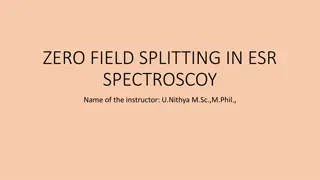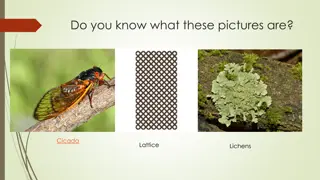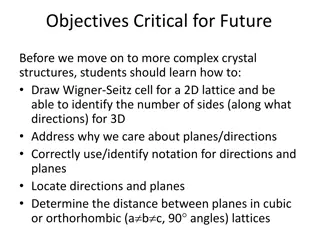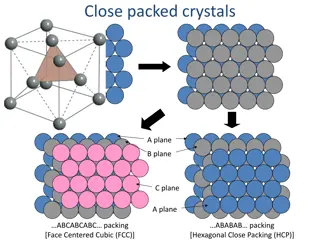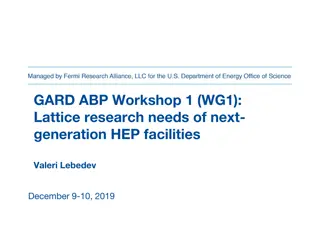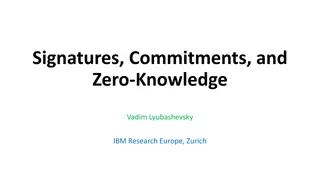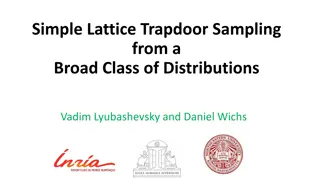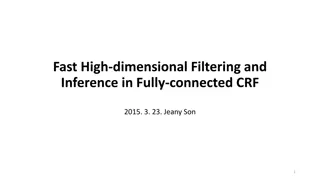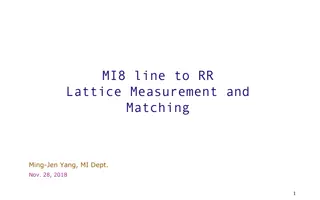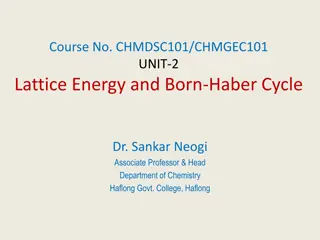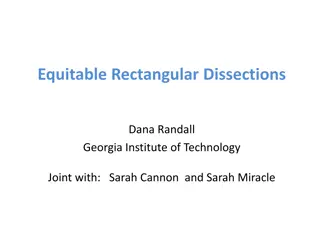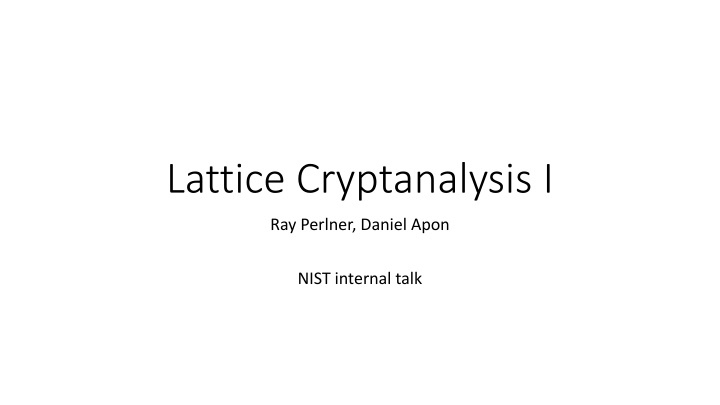
Understanding Lattice Cryptanalysis for Cryptosystems
Dive into the comprehensive talk series on lattice cryptanalysis, covering topics like BKZ overview, mathematical tools, LWE attacks, and more, aimed at distributing expertise within NIST. Explore the intricate world of breaking lattice cryptosystems efficiently.
Download Presentation

Please find below an Image/Link to download the presentation.
The content on the website is provided AS IS for your information and personal use only. It may not be sold, licensed, or shared on other websites without obtaining consent from the author. If you encounter any issues during the download, it is possible that the publisher has removed the file from their server.
You are allowed to download the files provided on this website for personal or commercial use, subject to the condition that they are used lawfully. All files are the property of their respective owners.
The content on the website is provided AS IS for your information and personal use only. It may not be sold, licensed, or shared on other websites without obtaining consent from the author.
E N D
Presentation Transcript
Lattice Cryptanalysis I Ray Perlner, Daniel Apon NIST internal talk
This talk series We want to internally distribute expertise on cryptanalyzing lattices Why? Every Finalist in Round 3 is a lattice, or it s not* subject to cryptanalysis *meaning it s McEliece or SPHINCS+, where we don t expect big breaks.. We wanted to force most people to give one hard talk on lattices. Seems the best way to ensure everyone gains some familiarity. What are our main goal(s)? Everyone learns how to calculate concrete bit-security of lattice schemes. Maybe spawn some of our own research into lattice cryptanalysis..
The sequence of talks in this series (and why) 1. Introduction to lattice cryptanalysis (Ray + DanielA) Give the high-level framework of the canonical attack: Lattice reduction/BKZ Everything else is a subroutine that plugs into this framework! Nguyen-Vidick Sieve (Angela) BGJ Sieve (Dustin) BGDL Sieve (Ray) Dimensions For Free (DanielST) Progressive Sieving (Yi-Kai) Jessica / G6K: the General Sieve Kernel (DanielA) Faster Lattice Enumeration (John + Quynh) More?? (Let s find any gaps along the way, and prepare more talks if so) Other topics like the Soliloquoy story are out there, and are interesting! (Research topic?) 2. 3. 4. 5. 6. 7. 8. 9.
This talk (outline) 1. BKZ overview (and how it helps break our lattice cryptosystems) 2. Some nice pictures of lattices 3. Mathematical tools for reasoning about BKZ Lattice determinant, Minkowski, the Gaussian Heuristic, GS Orthoganalization, QR factorization, HKZ reduction, the Gaussian Series assumption, etc. 4. The Primal attack and the Dual attack (guessing/hybrid attacks?) 5. How to attack LWE (how to attack NTRU) Turning cryptosystems (viewed as LWE/NTRU samples) into bad bases for BKZ 6. Discussion
What did we leave off for now? A short list.. 1. Quantum cryptanalysis (in general) 2. Soliloquoy (specifically) 3. How does algebraic structure play into any attack? (It doesn t..yet?) 4. Memory costing models CoreSVP vs Gate Count vs others (Area/Volume/Death Stars/Solar Computing)
Last preliminary issue: Lecture book Lecture book- -keeping keeping If we have interesting discussion along the way or if a speaker makes good comments not on slides, it would be good to keep an ongoing record of this on Sharepoint (where anyone can access it later). I recommend we adopt the scribing model, akin to lectures in a grad school course on a specialized topic Person A is giving a talk; Person B will be a scribe (Dustin is scribe today) Everyone tries to sign up for each job at most once, in a rotating schedule Person A prepares slides from a paper, gives a talk to the group Person B writes 1-2 pages of notes (in LaTeX?) capturing the main ideas, and uploads it somewhere (Sharepoint?) so that we can all access it later
BKZ Overview SVP asks to find the shortest nonzero vector, in an arbitrary lattice Algorithms for SVP (Sieving, Enumeration) Not the topic of this presentation In lattice crypto, best attacks come from solving Unique SVP (?-uSVP) Find the shortest nonzero vector (length ?1) In a lattice where the shortest nonzero vector is unusually short (?1< ? ?2) Approximate SVP (?-SVP) Find a short nonzero vector (length at most, ??1) In an arbitrary lattice Unique SVP and Approximate SVP are solved using BKZ BKZ needs to Solve SVP on lower dimensional lattices (dimension aka Block Size, ?) Polynomially many times We will call this subroutine an SVP oracle
Tools for reasoning about BKZ Lattice Determinant Minkowski s theorem Gaussian Heuristic Gram-Schmidt Orthogonalization QR factorization Geometric Series Assumption
Lattice Determinant det() What it says on the tin: Write lattice basis vectors as row vectors Stack them on top of one another making a ? ? square matrix Take the determinant of said matrix What it means The volume of the unit cell of the lattice i.e. the density of points in the lattice is Density of points in lattice does not depend on choice of basis So neither does the lattice determinant 1 det( )
Using det() to Bound/Estimate ?1 Minkowski s theorem 1 ? ?1 ? (det( )) Gaussian Heuristic ? 1 ? ?1 2?? (det( ))
Gram Schmidt Orthogonalization Start with a basis, (?1,?2, ,??) Create a set of orthogonal vectors (?1 of ??onto the space orthogonal to (?1,?2, ,?? 1) i.e. ?1 ?2 Etc. |?? lower dimensional space Since ?=1 |?? Bases where |?1 So, if you want short vectors in your basis, you will want |?? is the projection ), where ?? ,?2 , ?? = ?1 ?2,?1 |?1|?1 = ?2 | tends to decrease with increasing ?, as ??is projected onto an ever ? | = det( ) is independent of basis, | = |?1| is small, will have |?? | for other ? larger to compensate | to decrease slowly
Lattice reduction and Gram-Schmidt norm Bad Basis Good Basis ?? ?
QR factorization Related to Gram-Schmidt orthogonalization Let ? be a basis matrix with vectors as columns Can factor as ? = ?? ? is orthogonal ? is upper triangular Compute by rotating ?? onto the coordinate axes: ??,?1 ?1 ??,?2 ?2 ?? ?2,?1 ?1 ?2 ?1 ? = 0 0 0
HKZ reduction (What to do with an SVP oracle) Use QR factorization ??,?1 ?1 ??,?2 ?2 ?? ?2,?1 ?1 ?2 ?1 Note from the form of: ? = 0 0 0 1 Can subtract off vectors to the left of ?? so that ??,?? A basis is HKZ reduced if ??,?1 2 ?1 The projection of ?2, ?? orthogonal to ?1 2 1 = ?1 is HKZ reduced
BKZ algorithm HKZ reduce square submatrices of size ? Tour: Start at the top left and move down to the bottom right May require multiple tours before basis stops improving Neumaier argument based on reducedness parameter 1 ? ? ? ?|? |? ? ? ?|? |? ? max? ? ? ? ?2 ?2 Each tour before fixed point reduces ? by a factor 1 ?2 ?2log(log |?| ) tours i.e. ? ? ?2 ?2log(log |?| ) implies BKZ converges after ? oracle calls
Sandpile model illustration (From 2016 presentation by Stehl https://wheat2016.lip6.fr/HEAT_Paris_Damien.pdf)
Sandpile model illustration (From 2016 presentation by Stehl https://wheat2016.lip6.fr/HEAT_Paris_Damien.pdf)
Sandpile model illustration (From 2016 presentation by Stehl https://wheat2016.lip6.fr/HEAT_Paris_Damien.pdf)
Sandpile model illustration (From 2016 presentation by Stehl https://wheat2016.lip6.fr/HEAT_Paris_Damien.pdf)
Sandpile model illustration (From 2016 presentation by Stehl https://wheat2016.lip6.fr/HEAT_Paris_Damien.pdf)
BKZ basis quality Widely cited ADPS 2016 estimates are based on the Geometric Series Assumption that: Gram-Schmidt norms after reduction satisfy: = ?? 2? 1(det( )) And, therefore, for block size ?, BKZ achieves: 1 ? ?? 1 2(? 1) ? ? = (??)1/? 2?? Implications: For generic lattices, will find a short vector of length ?1 For lattices with a unique short vector ?, it will be found if the projection of ? onto the span of the last ? Gram-Schmidt basis vectors is shorter than ?? ? i.e. if ? ? ?? ? Some newer estimates, e.g. https://eprint.iacr.org/2020/1308.pdf , instead use simulations 1 ? = ??+1(det( )) 1 ? = ?2? ? 1(det( )) ? https://eprint.iacr.org/2020/1308.pdf
Turning NTRU and LWE into Lattice Problems
Attacks and Lattice Problems LWE and NTRU style cryptosystems get unique SVP and approximate SVP instances via various attack strategies: LWE (NewHope ADPS2016 terminology): Primal: uSVP Dual: Approximate SVP NTRU Primal , Dual attack Numbers are cited for Primal and Dual attack in NewHope paper Obvious analogy attempts message recovery where LWE attack would attempt key recovery Both of these can be uSVP (Approximate SVP may be relevant too for dual) Coppersmith-Shamir97, extended by May99 (this is called Primal in NTRU spec.): uSVP Howgrave-Graham05: Hybrid meet in the middle uSVP We will study these strategies in the next few slides
Product LWE (Typical LWE cryptosystem) KeyGen: Generate random matrix/module/polynomial: ? and short matrix/module: ?? Public key components: Dec: Calculate ?? ?? ?? ?? ?? ????= ? + ? ?? ?? ? ? ??= ?? ?? Main variant: Recover ? using noise tolerant encoding/ public ECC ??= ? Enc: Ouroboros Variant: Let ? = ? ?? ?? ?? Generate short matrix/module: ?? ?? ?? Instead Recover Using: Encode message noise tolerantly as ? MDPC decoder (BIKE-3) LRPC decoder (ROLLO-III) Ciphertext components: ?? ?? ??+ ? ?? ?? ? ? ? ? ?? ?? =
Primal Attack (1/3): A lattice associated with LWE ? ? ?? from ??= ?? = ??? + ?? (mod ?) ?? Want to recover short ?? (We only need to find one row at a time if it s a matrix, so treat as a single row vector) Note that ? ??? + ??(mod ?)is close to: ???(mod ?)) ?? = ? (?? A lattice point in the lattice given by basis (vectors are rows): ? ? ? ??
Primal attack (2/3) LWE as BDD Note that ? ??? + ??(mod ?)is close to: ???(mod ?)) ?? = ? (?? A lattice point in the lattice given by basis (vectors are rows): ? ? Finding an unusually close lattice point to a non-lattice point is called Bounded Distance Decoding (BDD) BDD can be converted to uSVP (finding an unusually short nonzero lattice vector) ? ??
Primal Attack (3/3) LWE recovery as uSVP (Bai-Galbraith Embedding) Increase the dimension by 1 and add ? resulting in: ?? ? to the lattice basis, ? ? ? ?? ? ?? ? ? ? ? is called the embedding factor, and its value can be adjusted Optimal value is typically ? 1 Now ?? ?? ?can be found as an unusually short vector in the above lattice.
Dual Attack ? ? Want distinguish ??= ?? random Dual attack strategy: Reduce a lattice that only depends on ? The lattice is defined as solutions ? Basis (vectors are columns): ?? = ??? + ?? (mod ?) from ? to ?? = ? (mod ?) ? ? ?? ? Distinguisher: If we have a short solution ? (??? + ??) ? = ??? + ??? (mod ?) is short ? to ?? = ?(mod ?):
Quotient LWE (NTRU) KeyGen: Generate short matrix/module: Dec: Calculate ?? ?? ?? ?? ?? ?? ??? = Public key: ??? ? = ?? Recover ?? Using: Enc: Generate short matrix/module: ?? NTRU Trapdoor (NTRU, sNTRUprime) MDPC decoder (BIKE-1,2, LEDAcrypt) LRPC decoder (ROLLO-I, II) ?? ?? Ciphertext: ?? ?? ? = ? ?
NTRU ((mostly) traditional notation) KeyGen: Generate short matrix/module: Dec: Calculate ? ? ? ? ? ? ?? = Public key: ? = ? ?? Recover ? Using: Enc: Generate short matrix/module: ? NTRU Trapdoor (NTRU, sNTRUprime) MDPC decoder (BIKE-1,2, LEDAcrypt) LRPC decoder (ROLLO-I, II) ? ? Ciphertext: ? ? ? = ? ?
NewHope style Primal attack on NTRU Want to recover short ? ? ? ? from ? = ? ? Recall the primal attack for (Product LWE) ? ? ?? from ??= ?? ?? Want to recover short ?? This is the same up to matrix transpose, assuming ? can be treated as a random matrix, like ?.
NTRU Lattice attacks Coppersmith-Shamir 1997 Construct a lattice from the public key = ? 1? (vectors are rows) ? ? Note that the rows of ? ? are short vectors Dimension reduction ( Run Lattices May 99), as many entries of ? are 0, can remove a number of columns and rows equal to maximum number of consecutive 0s and still have an unusually short vector in the lattice ? ??
Further Improvements in May99 More dimension reduction Lop of columns from one or both sides of Coppersmith-Shamir Lattice basis Now the rows of the basis are not linearly independent, so the lattice dimension is less rows of ? ? without the appropriate columns still in the dimension reduced lattice Solving for the rest of ? ? is easy Can be combined with the run lattices technique (see previous slide also May99)
Odlyzko Meet in the Middle attack; Howgrave-Graham Hybrid Attack Odlyzko (1997) meet in the middle attack: Write the polynomial ? = ?1+ ?2 , where ?1 has nonzero coefficients in the left half and ?2 has nonzero coefficients in the right half Since ? = ?1 + ?2 = ?, which has small coefficients, ?1 and ?2 nearly collide Can create lists of rounded values of ?1 and ?2 and look for collisions Howgrave-Graham (2007) combined this with lattice reduction to create an improved hybrid attack using a technique I will refer to as magic
References General references: Stehle, Review of Lattice Reduction Algorithm: https://wheat2016.lip6.fr/HEAT_Paris_Damien.pdf ADPS 2016 (NewHope Paper): https://eprint.iacr.org/2015/1092.pdf AGVW 2017: Revisiting the Expected Cost of Solving uSVP with applications to LWE: https://eprint.iacr.org/2017/815.pdf Kannan embedding: https://pdfs.semanticscholar.org/9253/08b01e1a3a9944774a817c63d84c887ee277.pdf Bai Galbraith Embedding: https://eprint.iacr.org/2013/839.pdf NTRU Cryptanalysis Coppersmith, Shamir 1997: https://link.springer.com/chapter/10.1007/3-540-69053-0_5 May 1999: https://citeseerx.ist.psu.edu/viewdoc/download?doi=10.1.1.41.3484&rep=rep1&type=pdf Howgrave-Graham 2005 (Hybrid attack): https://iacr.org/archive/crypto2007/46220150/46220150.pdf



